A New, Old Look for Main Building’s Ceiling

- This Collection of Alumni Stories is a Masterclass in Resilience
- Heard Around Campus — April 2025
- Carl June, MD, to Address Drexel College of Medicine Class of 2025 During Commencement
- Alumnus and Olympic Gold Medalist Justin Best to Address Graduates at Drexel’s University-wide Commencement Ceremony
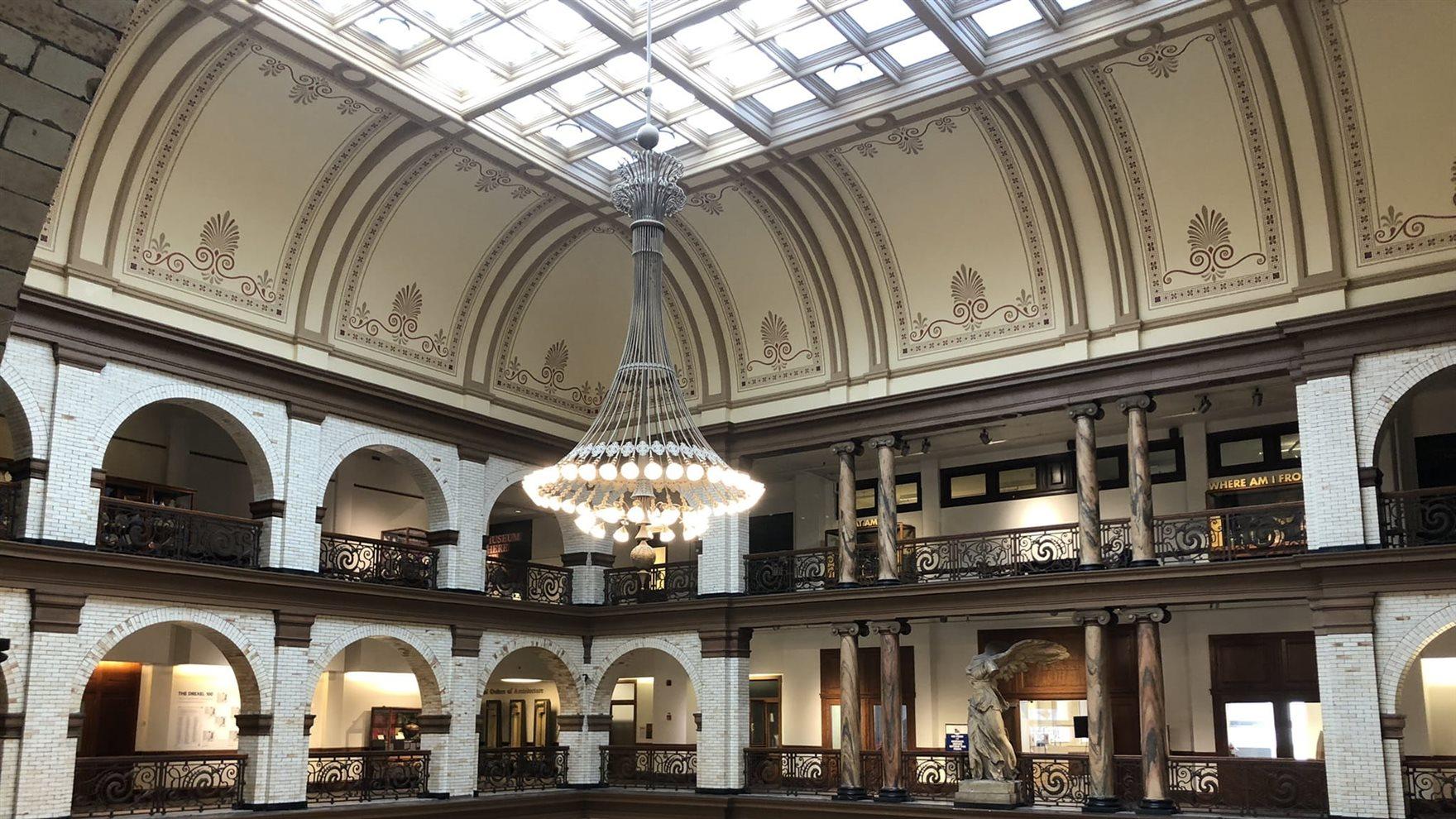
Earlier this month, after the four-story scaffolding was taken down and the expansive protective netting was removed, the Great Court ceiling in Drexel University’s Main Building was finally shown for the first time in four years. What Dragons and other visitors to the building can now see is completely different from the plain light blue ceiling from before. But what is displayed would look very familiar to people who visited the building more than a century ago.
Today’s beige ceiling with red and taupe ornate stenciling was chosen in honor of the original designs and coloring found under the nine layers of paint and plaster that was detected on the ceiling. It’s an updated version of what would have been seen when Main Building opened as the first and only building of the then-Drexel Institute of Art, Science and Industry in 1891.
“The Main Building has historic significance to Drexel and to the city,” said University Real Estate and Facilities Director of Design Kimberly Miller. “We felt it was important to respect its history and restore the ceiling to its original appearance.”
Though Drexel has expanded to three campuses and many, many buildings, Main Building still functions as the centerpiece of the University City Campus. In addition to housing academic and administrative offices, classrooms, art galleries, and laboratories, it often is the first Drexel building seen by potential Dragons and other visitors getting their first glimpse of the University during admissions tours and large events in the Great Court and Main Auditorium. Truly, it’s the only building on campus visited and used by a wide variety of people, and it’s the only building on campus that looks the way it does. That’s been true for its entire existence, as noted by George E. Thomas, PhD, an architectural historian, in “Drexel University: An Architectural History of the Main Building 1891–1991.”
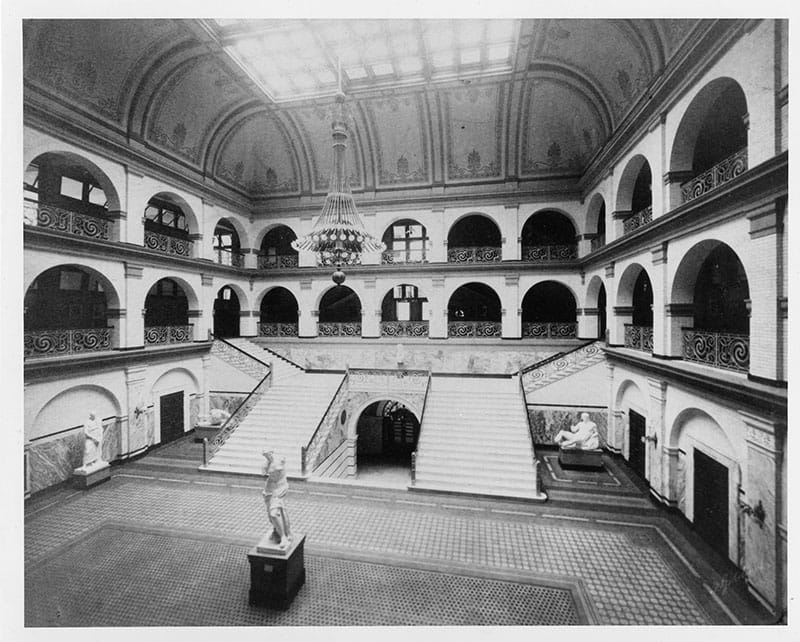
“[Main Building] was a direct reflection of the intentions of its founder, Anthony J. Drexel (1826–1893). Unlike most American colleges, whose Gothic-detailed buildings on green lawns, framed by ancient trees, recalled the origins of colleges in English religious communities, this was squarely situated on an urban corner, two blocks from the lines of the Pennsylvania Railroad and adjacent to the Allison Car Works. The building’s design was different as well; its walls were of a bright buff brick and terra cotta with ornament derived from classical sources, though following no specific European prototype,” Thomas wrote of Main Building’s location and exterior appearance.
Inside, the Main Building’s Great Court was — and continues to be — just as grand.
“Beyond the great portal [from the Chestnut Street entrance] a richly ornamented columned entrance hall opened, not into customary dark, narrow corridors, but into a vast light-filled, multi-story arcaded space, like the courtyard of an Italian palazzo, but roofed over by an expansive leaded glass skylight from the center of which hung a splendid chandelier. This great room was light in tone, accented with marble and terra cotta trim in the soft buff tints of the exterior, with antique red painted palmettes and borders in the cove of the ceiling,” wrote Thomas.
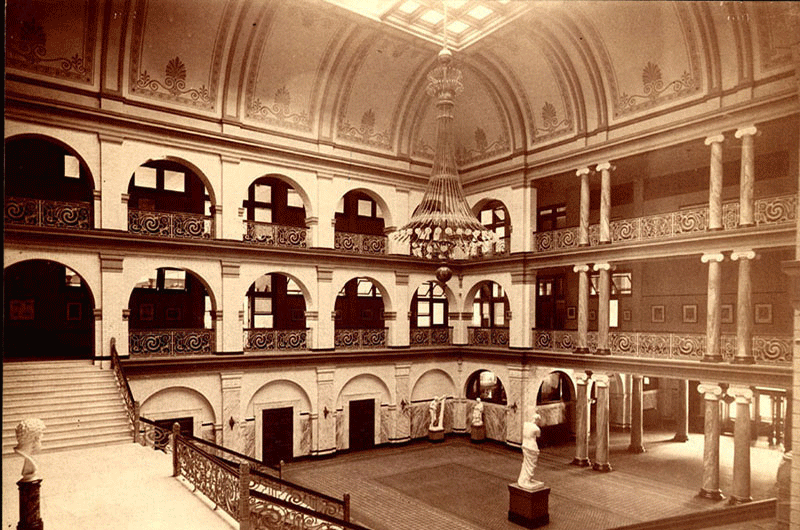
As noted in an 1893 booklet commemorating the Dec. 17, 1891 dedication ceremonies from the opening of the Drexel Institute of Art, Science and Industry, the Great Court’s “ceiling is paneled with oak. From this portico the visitor [entering from the Chestnut Street entrance] passes through the entrance-hall [sic], the ceiling of which is supported by marble columns, to the great court, sixty-five feet square, and fifty-six feet from the floor to the painted glass ceiling….The court is floored with tiling in which buffs and dull reds predominate. The ceiling is decorated in the same tints with the adaption of some of the conventional Greek forms.”
Over the years, the appearance of the Great Court ceiling changed, and not just from the different paint layers. In 1956, the Tidewater Grain Elevator located near 30th Street Station accidentally blew up due to highly combustible grain dust on the premises. In the Great Court, the ceiling’s stained glass shattered, raining down onto bystanders; afterwards, the undamaged Main Building chandelier was taken down, dismantled and placed into storage as part of the $300,000 (today, over $2.5 million) rebuilding process. That was the last documentation of what happened to it, as neither the storage place nor the chandelier were ever found (it didn’t help that the blueprints for Main Building are missing). A chandelier didn’t hang in the Great Court until 2006.
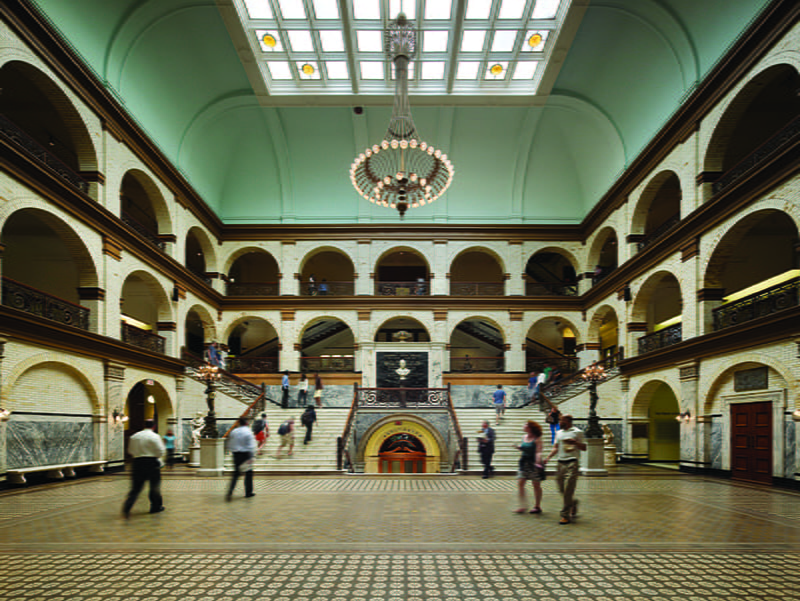
The 2021 restoration of the Great Court plaster ceiling was always intended to not only remove unsound parts of the ceiling where plaster and paint no longer adhered to the ceiling, but reintroduce the ceiling’s original appearance. It was first proposed as part of an assessment on Main Building in 2014 when Drexel hired the VITETTA architecture and engineering firm to oversee the yearlong roof and skylight project completed in March 2021 and led by VITETTA project manager and preservation expert Nan Gutterman, FAIA. EverGreene Architectural Arts, the historic preservation and architectural art specialty contractor hired for the conservation of the plaster ceiling, became involved in the project in the fall of 2021.
Archival images showed what the ceiling looked like in the years after Main Building’s official opening, though just a restoration to the original color, and not necessarily all of the designs painted on top of that, was originally planned. EverGreene completed a paint analysis to scientifically identify the paint colors for replication. Conservators discovered that the designs came from the ceiling’s first paint layer (which was a distemper paint, a cost-effective historic paint system applied directly to plaster, without a primer). There’s strong evidence that this system was washed off before it was painted over, but they were able to find evidence of the original Greek key patterned borders and stylized palmette designs during this restoration and repainting phase of the restoration process, which was enacted in October.

“The intention always was to determine the original color palette and repaint the ceiling accordingly,” said Miller. “When we did the investigation to determine the paint palette, we were able to uncover some portions of the original stencil. This allowed us to more accurately reproduce the design, and our consultant team of VITETTA and EverGreene were able to devise a plan to replicate the pattern in an efficient way so the project could be completed in a timely manner.”
When less plaster than budgeted for ended up being used, the restoration plan was adjusted to take advantage of the scaffolding already set up and use the project savings to add the stenciled designs. EverGreene developed the stencils after the sizes of the original Greek key pattern, stylized palmette designs and other flourishes were measured and then, based on those measurements, dimensions of other elements were extrapolated through computer modeling.
This all happened behind the scenes and also on the top of some very tall scaffolding that spanned the entirety of the Great Court and reached all the way to the top of the building. Scaffolding was erected in various stages — with levels at each of the four floors in Main Building — starting in November 2021, and was taken down in February. During those four months, visitors to Main Building navigated through the tight, restrictive maze of scaffolding.
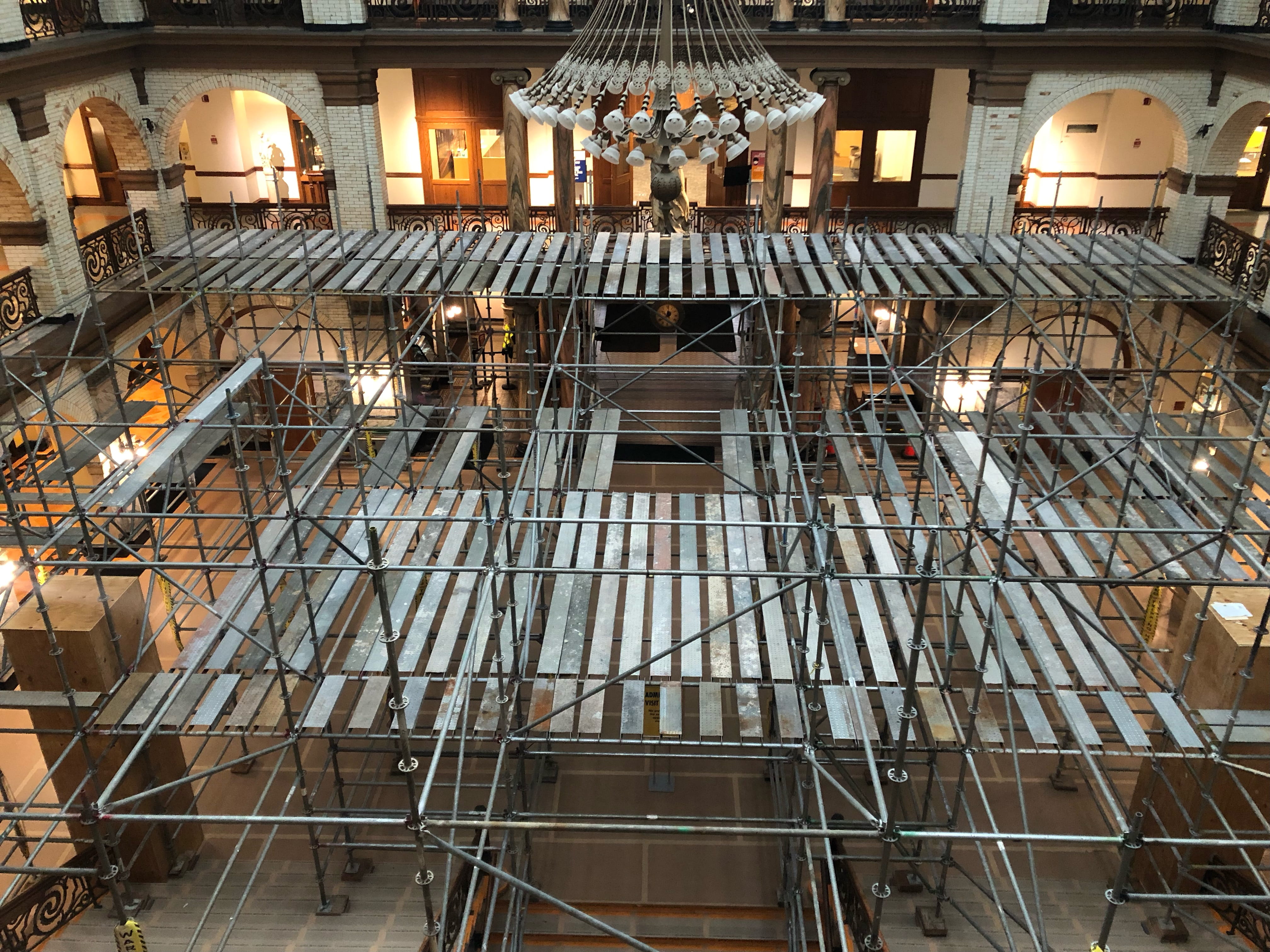
The construction that was an annoyance to some became an artistic opportunity and a teachable moment for others.
Mark Stockton, associate teaching professor in the Westphal College of Media Arts and Design’s Department of Art and Art History, used the opportunity to teach students in his “Tablet Drawing” (Visual Studies 114) course this term through a perspective study of the Main Building and its scaffolding.
Two sections of “Tablet Drawing” students spent one full class drawing the scaffolding. It was an exercise to use a digital perspective assist tool (Adobe Fresco and Procreate programs) to better understand how to identify the elements of linear perspective in composition.
“In Visual Studies, we make a strong effort to connect observational drawing to our local environments,” said Stockton. “For many Drexel faculty, the Main Building has become a compelling site for understanding perspective and architectural space. The scaffolding enhanced this space with even more linear complexity. You can tell from the drawings that the students had a great time getting into the details.”





Other changes to Main Building during the restoration process included protective covering laid on top of the Great Court’s tiled floor and marble staircase. The statuary was also encased by wooden boxes for protection, including the famous Water Boy and Sappho statues on either side of the staircase, the conical clock on the western side of the Great Court, the bust of Anthony J. Drexel on the staircase and the candelabra on top of the staircase (which, like other pieces of art on campus, was originally owned by the founder). The encasing and layering were taken down in mid-February, as viewed in these photos and video.
This is the second restoration project in recent years in which features of Main Building were restored to resemble their original 1891 appearance. In 2018, the doors and woodwork of the Chestnut Street doorway were painted brown after a paint analysis revealed the original 1891 layer of dark brown paint; 23 layers of paint were detected, including black, green, brown, yellow, white, off-white and, most recently before the restoration project, beige paints.
Now that both the roof and skylight project and the Great Court ceiling projects are complete, the next major restoration project for Main Building will be the conservation and repair of the exterior masonry — the brick and terra cotta — this spring.
In This Article
Drexel News is produced by
University Marketing and Communications.

